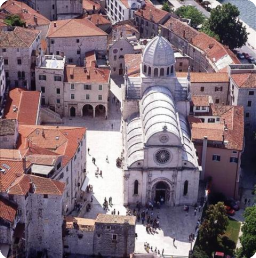

Šibenik
Šibenik  History of Šibenik
History of Šibenik
Among all the Croatian towns on the Adriatic coast, Šibenik stands out for its unique location in a picturesque and large bay at the mouth of the River Krka. Created initially as a garrison, fort or camp beneath the St. Michael’s Fortress that still dominates the town, Šibenik was mentioned for the first time in 1066 in a document issued by the most important Croatian ruler: King Petar Krešimir IV. Šibenik obtained the status of town in 1298, when the Diocese of Šibenik was established.
A view of Šibenik reveals the unique harmony of the urban poetics of the town and its natural surroundings. The harbour, connected with the open sea by the Straits of St. Anthony, has been the driving force in the development of seafaring, trading and the overall economic prosperity of the town for centuries. At the entrance into the straights, there is the fortress of St. Nicholas, the most important Renaissance fortress on the eastern coast of the Adriatic. This fortress, together with the fortresses of St. Michael, St. John and Šubićevac, which all surround the town, are a symbol of the centuries-long resistance of Šibenik, which was confirmed in the recent Homeland War.
St. Jacob’s, the Cathedral of Šibenik, which took over a century to build is a testimony to the persistence, sacrifice and belief of generations of inhabitants of Šibenik. In many respects, it is unique not only in Croatian architecture, but in European building as well: it is entirely built of stone, no other material being used; it is unique in terms of its structure of stone slabs and ribs without any binding material; it is also unique among Renaissance churches because of its trefoil front facade; finally, it is unique because of the harmony of its architecture and row of 71 sculptures around the apses.
Documents preserved from the time of the construction of the cathedral show that the entire community contributed to its building, including a large number of local stone masons, builders and artisans. The most important among them was Juraj Matejev Dalmatinac, who came from Zadar and who the town of Šibenik commissioned in 1441 to take over the job of chief architect of the cathedral of Šibenik. The Cathedral, nearby Renaissance town hall, other churches, palaces, and the Prince’s Palace, which currently houses the County Museum, probably constitute the most beautiful town square in Croatian urban heritage.
In the 15th, and the 16th century, Šibenik was among Croatia's most important centres of humanism and the Renaissance. Here, the following lived and worked: the writers Juraj Šižgorić, Antun and Faust Vrančić, Petar Divnić and Ivan Polikarp Severitan; the composers Ivan Šibenčanin, Julije Skjavetić and Ivan Lukačić; the historian Dinko Zavorović; the painters Nikola Vladanov and Juraj Čulinović; the printers Martin Kolunić-Rota, Horacije Fortezza and Natal Bonifacij; and many sculptors and builders from the circle of Juraj Matejev Dalmatinac.
The scientist, visionary, lexicographer, writer, philosopher and theologian, Faust Vrančić, is the best known figure of the Croatian Renaissance. The writer of the first Croatian dictionary, as well as the author of the famous book of inventions, Machinae Novae (New Machines), among his many ideas, the one that stands out is the drawing of homo volans, the flying man, the first printed picture of a parachutist in history.
The 14th century church and monastery of St. Francis, the first Croatian national shrine of St. Nikola Tavelić, has been an important ecclesiastical and cultural centre for centuries. In the monastery collection, there are over 150 incunabula and many valuable manuscript codices, including the famous Šibenik Prayer, the first Croatian poetry written in the Latin script.
In the church, there are organs made by the well-known Croatian organ designer of the 18th century, Petar Nakić, preserved in their original form. The present vibrant cultural life of Šibenik is evident in the traditional International Children's Festival of Šibenik.
Video
Current news
 Macrocruise charter agency
Additional discount on the boat rental price of betw
Macrocruise charter agency
Additional discount on the boat rental price of betw

























